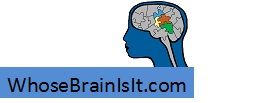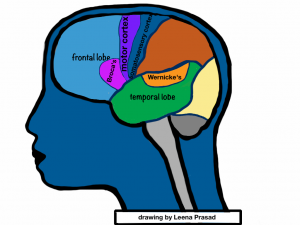Presented within the flow of the lives of real people and fictional characters, this is a monthly exploration of how some parts of the brain work.
World of Words
Wendy has to stay at home with her mother while her siblings go to Universal Studios with their father. She is recovering from flu and her parents want her to take it easy. She is unhappy about the situation and sulks as her siblings go off to have a day of fun.
But when her siblings return from their adventure, Wendy is flush with excitement and does not even notice them. Her mother has given her a story book set inIndia. Wendy lives in a small town in theUS, nearLos Angeles. She is 15-yrs-old and has just started to discover the cultures of other countries. A particular scene in one of the stories fires up her imagination “a rainbow of colors swirled in the air and she closed her eyes just before the red-yellow-blue-green-purple powders landed on her white shirt.”
Wendy is engrossed in the exotic scenes in the book and her brain is having an adventure that’s comparable to that of her siblings’. The meaning of the sentences, paragraphs, and the entire narrative, is parsed by language processing centers in the brain called Broca’s area in the frontal lobe and Wernicke’s area in the temporal lobe. For a long time, neuroscientist understood that Broca’s area is used for reading aloud and for producing language and that Wernicke’s is used for comprehension. But, according to studies cited in the New York Times and study results published in an article in the Harvard Crimson, Broca’s area is used for comprehension also.
The processing does not end once the meaning of the words is parsed. Some of the other regions that are involved in further analysis are motor and somatosensory cortexes. These areas catapult the experience from beyond the understanding of the story and characters into simulating the experience for the reader. It’s not exactly like the 4D simulation of Universal Studios, but it is much more individualized than the rides at the amusement park and can entertain longer depending on the length of the story being read.
Per neuroscience studies cited in the book Words to Brain and in a New York Times article, the actions of characters in Wendy’s book activate the motor cortex and the somatosensory cortex in the frontal lobe. The motor cortex, as the name implies, sends signals to other parts of the body for the coordination of movements, like walking, dancing, eating, etc. The somatosensory cortex manages the sensations of touching. Other parts of the brain are also engaged in the process of simulating the reading experience and more research is being done to comprehend the details.
When Wendy’s imagination recreates the scenes and the experiences of the characters, her brain experiences the event as if the scene had occurred in front of her or perhaps even to her. As she reads about the Indian festival of holi, her mind’s eye sees the colorful powders falling, the smile people dresses in white, the colors landing on their clothes…The words on the page activate her brain in a similar manner that it would be activated had she been part of the story.
Neuroscientists are only beginning to study the biological basis of the power of reading but good storytellers have known how to exploit it for centuries. Most avid fiction readers are familiar with the experience of getting lost in a story filled with compelling emotions, evocative scenes, and hypnotic storyline. Of course, the success of a story in achieving movement and sensory activation of the brain is dependent on the skill of the writer in communicating the narrative to the reader. As the characters move around slyly and playfully, filling up water guns with colored water or their hands with colored powder, Wendy experiences the scene only as vibrantly as the author is able to recreate it.
| topic | words |
| regions | Broca’s area, Wernicke’s Area, motor cortex, somatosensory cortex, and other regions |
Upcoming…
March: aphasia, a disorder in producing and comprehending words
Leena Prasad has a writing portfolio at http://www.FishRidingABike.com. Links to earlier stories in her monthly column can be found at http://www.WhoseBrainIsIt.com.
Dr. Nicola Wolfe is a neuroscience consultant for this column. She earned her Ph.D. in Clinical Psychopharmacology fromHarvardUniversityand has taught neuroscience courses for over 20 years at various universities.
References:
- The New York Times. Your Brain On Fiction, March 17, 2012. http://www.nytimes.com/2012/03/18/opinion/sunday/the-neuroscience-of-your-brain-on-fiction.html
- Blackburne, Livia. From Words to Brain (Can neuroscience teach you to be a better writer?).
- The Harvard Crimson. Broca’s Area May Have New Function, October 19, 2009. http://www.thecrimson.com/article/2009/10/19/language-brain-brocas-word/
- Pub Med. Broca’s area plays a role in syntactic processing during Chinese reading comprehension, April 2008, http://www.ncbi.nlm.nih.gov/pubmed/18255103


